Topic 5: Misc. Questions
You plan to deploy a containerized web app that will be hosted in five Azure Kubernetes Service (AKS) clusters. Each cluster will be hosted in a different Azure region. You need to provide access to the app from the internet. The solution must meet the following requirements:
• Incoming HTTPS requests must be routed to the cluster that has the lowest networklatency.
• HTTPS traffic to individual pods must be routed via an ingress controller.
• In the event of an AKS cluster outage, failover time must be minimized.
What should you include in the solution? To answer, select the appropriate options in the answer area.
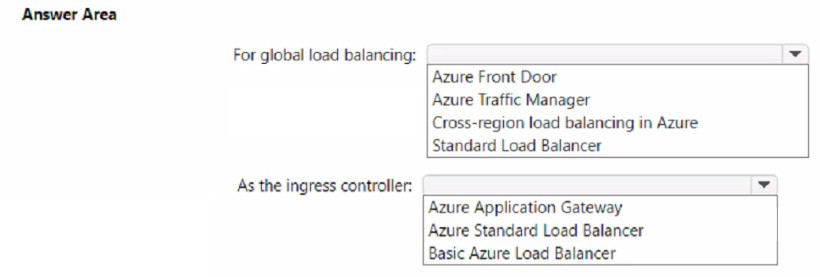
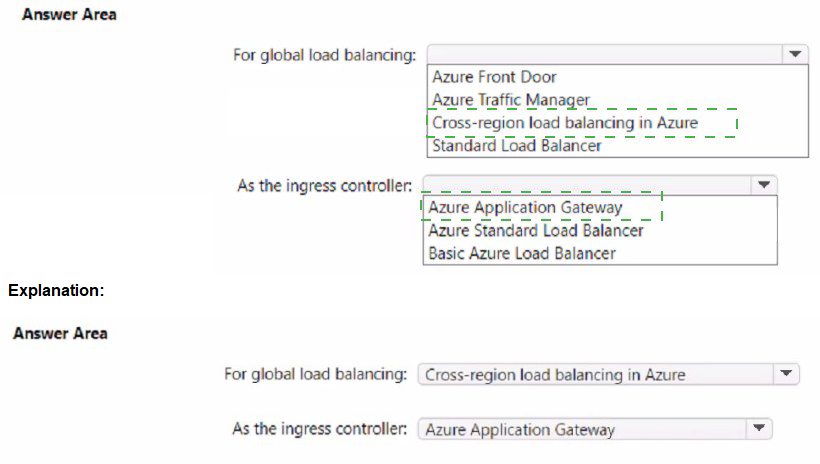
You have an app named App1 that uses two on-premises Microsoft SQL Server databases named DB1 and DB2.
You plan to migrate DB1 and DB2 to Azure.
You need to recommend an Azure solution to host DB1 and DB2. The solution must meet the following requirements:
• Support server-side transactions across DB1 and DB2.
• Minimize administrative effort to update the solution.
What should you recommend?
A.
two SQL Server databases on an Azure virtual machine
B.
two Azure SQL databases on different Azure SQL Database servers
C.
two Azure SQL databases in an elastic pool
D.
two Azure SQL databases on the same Azure SQL Database managed instance
two Azure SQL databases on the same Azure SQL Database managed instance
Explanation:
When both the database management system and client are under the same ownership (e.g. when SQL Server is deployed to a virtual machine), transactions are available and the lock duration can be controlled.
Reference:
https://docs.particular.net/nservicebus/azure/understanding-transactionality-in-azure
Note: This question is part of a series of questions that present the same scenario. Each question in the series contains a unique solution that might meet the stated goals. Some question sets might have more than one correct solution, while others might not have a correct solution.
After you answer a question in this section, you will NOT be able to return to it. As a result, these questions will not appear in the review screen.
Your company has deployed several virtual machines (VMs) on-premises and to Azure.
Azure ExpressRoute has been deployed and configured for on-premises to Azure connectivity.
Several VMs are exhibiting network connectivity issues.
You need to analyze the network traffic to determine whether packets are being allowed or denied to the VMs.
Solution: Use the Azure Traffic Analytics solution in Azure Log Analytics to analyze the network traffic.
Does the solution meet the goal?
A.
Yes
B.
No
No
Explanation:
Instead use Azure Network Watcher to run IP flow verify to analyze the network traffic.
Reference:
https://docs.microsoft.com/en-us/azure/network-watcher/network-watcher-monitoringoverview
https://docs.microsoft.com/en-us/azure/network-watcher/network-watcher-ip-flow-verifyoverview
Your company develops Azure applications.
You need to recommend a solution for the deployment of Azure subscriptions. The solution must meet the following requirements:
What should you include in the recommendation?
A.
Provision resource groups.
B.
Support deployments across all Azure regions.
C.
Create custom role-based access control (RBAC) roles.
D.
Provide consistent virtual machine and virtual network configurations.
Provide consistent virtual machine and virtual network configurations.
Explanation:
Resource groups: You can scope your deployment to a resource group. You use an Azure Resource Manager template (ARM template) for the deployment.
Regions: If you have a template spec in one region and want to move it to new region, you can export the template spec and redeploy it.
RBAC: Azure role-based access control (Azure RBAC) is the authorization system you use to manage access to Azure resources. To grant access, you assign roles to users, groups, service principals, or managed identities at a particular scope. In addition to using Azure PowerShell or the Azure CLI, you can assign roles using Azure Resource Manager templates. Templates can be helpful if you need to deploy resources consistently and repeatedly. You can setup Virtual machines and virtual network configurations in an Azure Resource Manager template.
Reference:
https://docs.microsoft.com/en-us/azure/governance/blueprints/overview
https://docs.microsoft.com/en-us/azure/azure-resource-manager/management/microsoftresources-move-regions
https://docs.microsoft.com/en-us/azure/role-based-access-control/role-assignmentstemplate
https://docs.microsoft.com/en-us/azure/virtual-machines/windows/template-description
You plan to migrate DB1 and DB2 to Azure.
You need to ensure that the Azure database and the service tier meet the resiliency and business requirements.
What should you configure? To answer, select the appropriate options in the answer area.
NOTE: Each correct selection is worth one point.
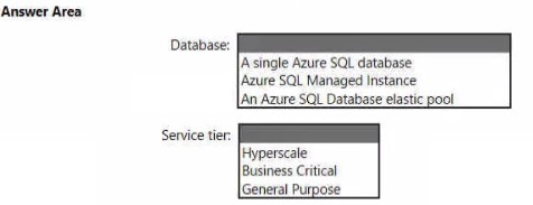

You have a resource group named RG1 that contains the objects shown in the following table.

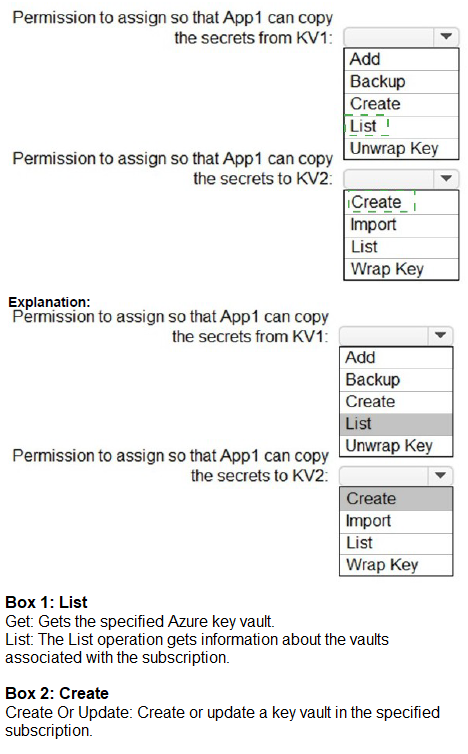
You architect a solution that calculates 3D geometry from height-map data.
You have the following requirements:
Perform calculations in Azure.
Each node must communicate data to every other node.
Maximize the number of nodes to calculate multiple scenes as fast as possible.
Require the least amount of effort to implement.
You need to recommend a solution.
Which two actions should you recommend? Each correct answer presents part of the solution.
NOTE: Each correct selection is worth one point.
A.
Create a render farm that uses Azure Batch.
B.
Enable parallel file systems on Azure.
C.
Enable parallel task execution on compute nodes.
D.
Create a render farm that uses virtual machine (VM) scale sets.
E.
Create a render farm that uses virtual machines (VMs).
Create a render farm that uses Azure Batch.
Enable parallel task execution on compute nodes.
Your company deploys several Linux and Windows virtual machines (VMs) to Azure. The VMs are deployed with the Microsoft Dependency Agent and the Microsoft Monitoring Agent installed by using Azure VM extensions. On-premises connectivity has been enabled by using Azure ExpressRoute.
You need to design a solution to monitor the VMs.
Which Azure monitoring services should you use? To answer, select the appropriate Azure monitoring services in the answer area.
NOTE: Each correct selection is worth one point.

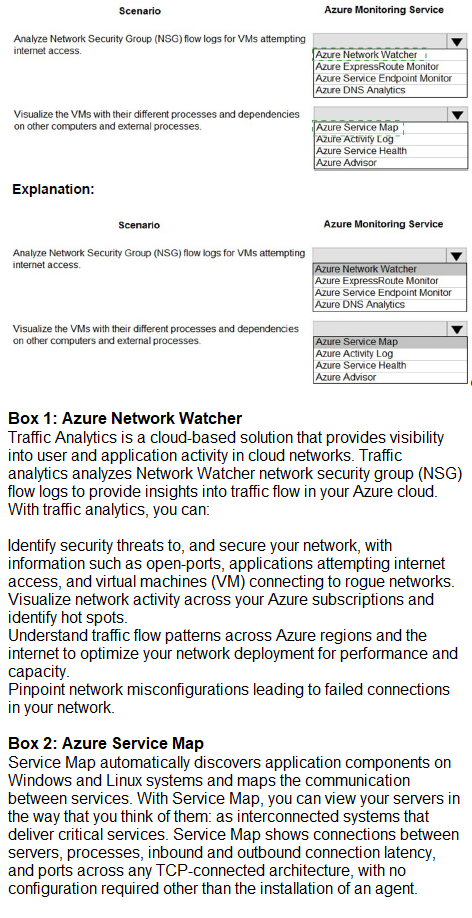
You have an on-premises line-of-business (LOB) application that uses a Microsoft SQL Server instance as the backend.
You plan to migrate the on-premises SQL Server instance to Azure virtual machines.
You need to recommend a highly available SQL Server deployment that meets the following requirements:
• Minimizes costs
• Minimizes failover time if a single server fails
What should you include in the recommendation?
A.
an Always On availability group that has premium storage disks and a distributed network name (DNN)
B.
an Always On Failover Cluster Instance that has a virtual network name (VNN) and a premium file share
C.
an Always On Failover Cluster Instance that has a virtual network name (VNN) and a standard file share
D.
an Always On availability group that has premium storage disks and a virtual network name (VNN)
an Always On availability group that has premium storage disks and a distributed network name (DNN)
You have an Azure Active Directory (Azure AD) tenant that syncs with an on-premises Active Directory domain.
You have an internal web app named WebApp1 that is hosted on-premises. WebApp1 uses Integrated Windows authentication.
Some users work remotely and do NOT have VPN access to the on-premises network.
You need to provide the remote users with single sign-on (SSO) access to WebApp1.
Which two features should you include in the solution? Each correct answer presents part of the solution.
NOTE: Each correct selection is worth one point.
A.
Azure AD Application Proxy
B.
Azure AD Privileged Identity Management (PIM)
C.
Conditional Access policies
D.
Azure Arc
E.
Azure AD enterprise applications
F.
Azure Application Gateway
Azure AD Application Proxy
Conditional Access policies
Explanation:
A: Application Proxy is a feature of Azure AD that enables users to access on-premises web applications from a remote client. Application Proxy includes both the Application Proxy service which runs in the cloud, and the Application Proxy connector which runs on an on-premises server. You can configure single sign-on to an Application Proxy application.
C: Microsoft recommends using Application Proxy with pre-authentication and Conditional Access policies for remote access from the internet. An approach to provide Conditional Access for intranet use is to modernize applications so they can directly authenticate with AAD.
You have an app that generates 50,000 events daily.
You plan to Stream the events to an Azure event hub and use Event Hubs Capture to implement cold path processing Of the events Output Of Event Hubs Capture will be consumed by a reporting system.
You reed to identify which type of Azure storage must be provisioned to support Event Hubs Capture, and which inbound data format the reporting system must support.
What should you identity? To answer. select the appropriate options in the answer area.
NOTE: Each correct selection is worth one point.
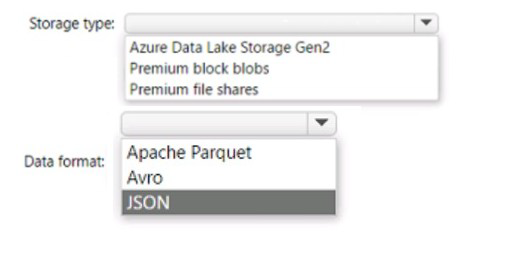
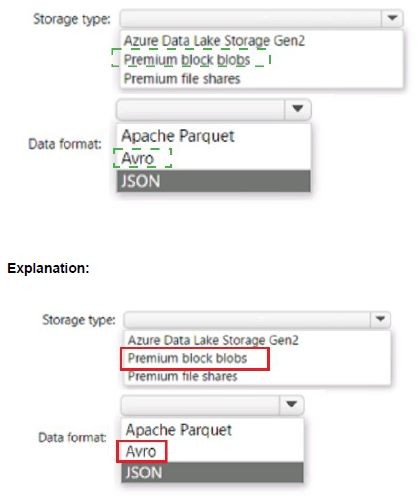
You are designing an application that will use Azure Linux virtual machines to analyze video files. The files will be uploaded from corporate offices that connect to Azure by using ExpressRoute.
You plan to provision an Azure Storage account to host the files.
You need to ensure that the storage account meets the following requirements:
• Supports video files of up to 7 TB
• Provides the highest availability possible
• Ensures that storage is optimized for the large video files
• Ensures that files from the on-premises network are uploaded by using ExpressRoute
How should you configure the storage account? To answer, select the appropriate options in the answer area.
NOTE: Each correct selection is worth one point.
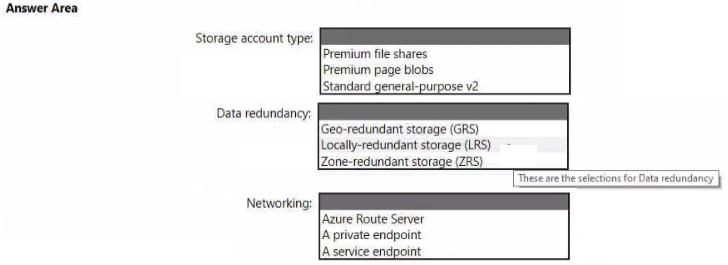
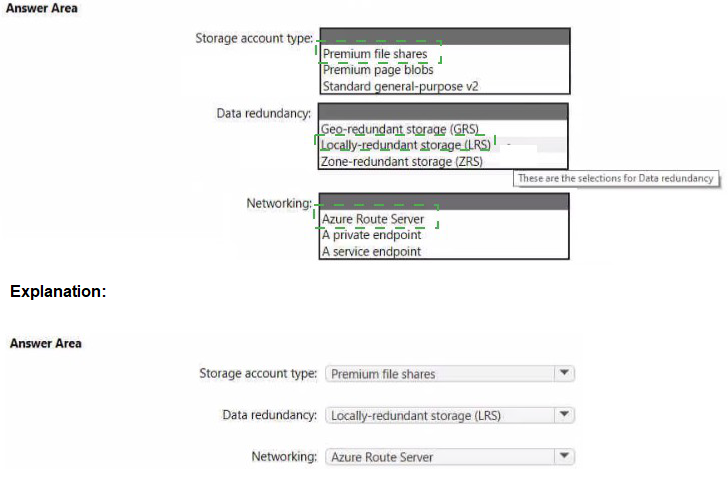
| Page 10 out of 24 Pages |
| Previous |